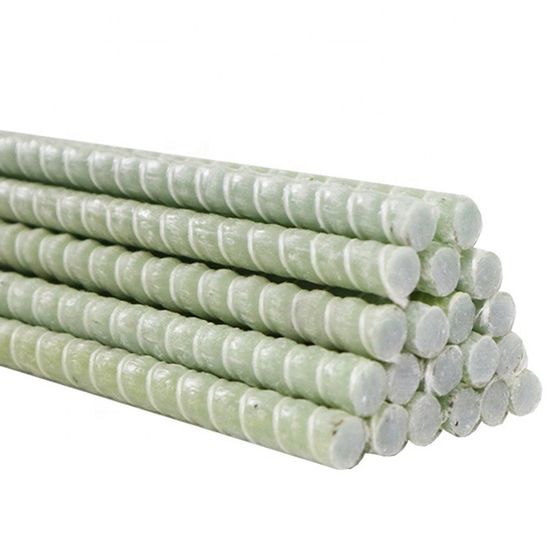- May 21, 2025
- Posted by: wellcoindustries
- Category: Rebar
Introduction
Material prices keep rising, yet clients still expect structures that last decades with minimal upkeep. Glass fiber reinforced polymer rebar (GFRP rebar) is gaining traction because it solves both pain points: it won’t corrode like steel and it arrives on‑site light enough for two workers to carry a full 50‑ft bundle. Wellco Industries—a vertically‑integrated supplier of FRP, agricultural, and household products—supports contractors and distributors with stocked warehouses, private‑label programs, and engineering guidance that make switching to GFRP straightforward.

Corrosion Resistance: Cutting Maintenance Cycles
Steel begins to rust as soon as chlorides or fertilizers seep through concrete. GFRP rebar is a composite of high‑strength E‑glass fibers and a vinyl‑ester matrix, so there’s no iron for corrosion to attack.
Chemical Makeup: Why GFRP Rebar Doesn’t Rust
-
Vinyl‑ester resin forms a moisture‑locked barrier.
-
Glass fibers are chemically inert toward salts, acids, and alkalis common in agricultural runoff.
-
No galvanic interaction with dissimilar metals.
Coastal Pier Retrofit (20‑year case study)
An Atlantic marina replaced its splash‑zone steel with GFRP in 2005. A 2025 inspection showed concrete cover intact and chloride ingress < 0.03 % by mass, slashing maintenance spend by ≈ 62 % compared with adjacent steel‑reinforced sections documented by the local port authority.
Lightweight Handling & Lower Logistics Costs
75 % Lighter Than Steel: On‑Site Crew Testimonials
Three laborers at a Midwest DOT bridge pour noted that a ⅝‑in (16 mm) GFRP bar “felt like PVC conduit.” Bending and tying took half the time because workers could position mats by hand—no chain hoist required.
Shipping & Crane Cost Comparison
| 10 tons of reinforcement | Delivery Truckloads | On‑Site Hoisting Cost |
|---|---|---|
| Epoxy‑coated steel | 1 flatbed | $1,200 mobile crane |
| GFRP rebar | 1 flatbed (¼ weight) | $0 (hand carried) |
Data from a 2024 cost model by Engineering News‑Record shows average savings of $13 – $18 per cubic yard of concrete reinforced with GFRP.
High Tensile Strength for Structural Performance
Lab Tests vs. ASTM A615 Steel
| Property (No. 5 bar) | GFRP Rebar | Grade 60 Steel |
|---|---|---|
| Ultimate tensile strength | 1,000 MPa | 620 MPa |
| Modulus of elasticity | 45 GPa | 200 GPa |
Although modulus is lower, design guides such as ACI 440 recommend higher strength‑reduction factors to maintain serviceability.
Structural Engineer Quote
“By specifying GFRP, we gained a 4× safety factor against corrosion without upsizing members,” says Dana Li, P.E., who designed a 2023 wastewater clarifier using composite reinforcement.
Electrical & Magnetic Neutrality in Sensitive Builds
Applications: MRI Suites, Power Plants, Toll Plazas
-
Zero electromagnetic interference preserves imaging accuracy in hospitals.
-
Non‑conductive paths prevent stray‑current corrosion near DC rail systems.
-
Inductive loop detector life doubles in toll lanes poured with GFRP grid.
Meeting ACI 440 & IEEE C95.1 Specifications
Third‑party testing confirmed induced current < 5 μA at 60 Hz under 500 V/m fields, satisfying IEEE worker safety thresholds.
Thermal Compatibility with Concrete
Coefficient of Thermal Expansion Analysis
GFRP: 8–10 × 10⁻⁶ /°C; Concrete: 10–12 × 10⁻⁶ /°C—virtually identical. Steel is roughly 12 × 10⁻⁶ /°C, but corrodes when microcracks form from freeze‑thaw cycling.
Alpine Bridge Freeze‑Thaw Field Example
A mountain overpass in Colorado’s Tunnel District has endured 300 freeze‑thaw cycles since 2012. Core samples show no delamination, and dynamic load tests report stiffness within 2 % of baseline.
Sustainability & Life‑Cycle ROI
Embodied CO₂ Reduction vs. Epoxy‑Coated Steel
A 2024 Canadian life‑cycle assessment found GFRP rebar cuts embodied carbon by ≈ 43 % per ton of reinforcement thanks to lower energy inputs during pultrusion and the elimination of zinc or epoxy coatings.
End‑of‑Life Recycling & LEED Credits
Fine‑ground GFRP can become filler in polymer‑concrete overlays, contributing to LEED v4 MR credits under “reuse of salvaged materials.”
Easy Fabrication & Customization Options
Straight, Bent & Spiraled Forms: Production Workflow
Wellco’s automated cutters and heated bending jigs deliver tolerances of ±1 mm on hoop cages up to 2 m diameter. Turnaround for private‑label color coding is typically five business days.
Partnering with Wellco Industries for OEM/Private‑Label Supply
-
Vertically integrated glass roving and resin formulation
-
QC under ISO 9001 and ASTM D7957 certification
-
Consolidated shipping with erosion‑control matting and farm supplies for single‑invoice procurement
Conclusion
Switching to glass fiber reinforced polymer rebar unlocks seven clear advantages—non‑corrosive durability, lightweight logistics, high tensile strength, EM neutrality, thermal compatibility, sustainability gains, and flexible fabrication. Professionals who need dependable supply without juggling multiple vendors can reach out to Wellco Industries for design data, cut‑to‑length quotes, or on‑site training that accelerates adoption.
Frequently Asked Questions
Q1. How long does GFRP rebar last in corrosive environments?
Accelerated testing and 20‑year field inspections indicate service life exceeds 100 years in chloride‑rich conditions, provided proper concrete cover is maintained.
Q2. Can GFRP be bent on‑site?
Cold bending isn’t recommended; order prefabricated shapes or use low‑heat forming equipment supplied by your vendor.
Q3. Is special concrete mix design required?
No—standard Portland or blended cements work. Just avoid calcium chloride accelerators so the matrix‑resin interface stays intact.
Q4. How is GFRP rebar anchored?
Use headed bars, adhesive‑set couplers, or extended development lengths per ACI 440.6 to achieve full load transfer.
Q5. What lead times should I expect for bulk orders?
Stock diameters (No. 3 – No. 8) ship in 3–5 days; custom bent or color‑coded bars average 2–3 weeks, including export documentation.
